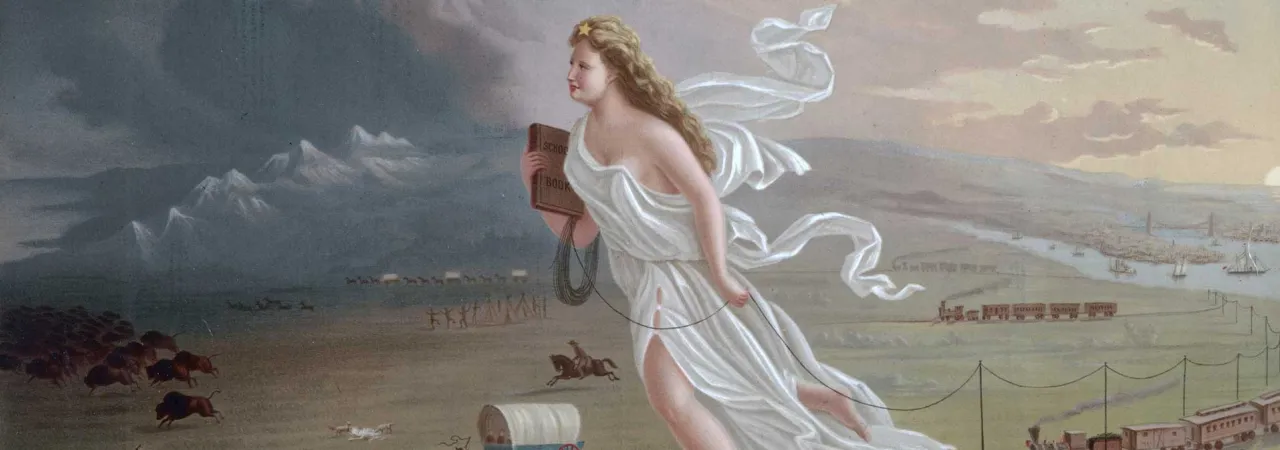
"American Progress" by John Gast, 1872
On the surface, it may seem that the War of 1812 was just pointless bloodshed spattered on the pages of human history. After all, according to the final Treaty of Ghent, all relations and borders were supposed to return to status quo ante bellum, or pre-war, status. Look beyond the legalism and into the practical effects of the war, however, and one will find significant attitudinal changes in the United States after the conflict, ushering in what most historians consider the “Era of Good Feelings” in the decade following the war.
The biggest American casualty of the war was the Federalist Party, the first political party that had arisen in the United States. A party of bankers and businessmen, the Federalists' steady opposition to the war doomed them in the eyes of the American public. Their vociferous opposition to the commencement of the war, and their subsequent contemplation of outright secession at the "Hartford Convention," angered many Americans, who viewed the Federalists as “un-patriotic.” The Federalists had principally represented men of means and wealth, with the bulk of their membership in the Northeast. With the end of the war the party all but ceased to exist, and many of its former members rallied to new party banners, namely Republican and Whig, where they formed the political base for centralization, protectionism, and, eventually, abolitionism, in the latter half of the 19th century.
When the war ended, Americans seized on the various successes of the Army and Navy and celebrated the fact that the relatively young United States had gone toe to toe with the greatest military machine in the world, fighting them mostly to a draw. The huge victory scored by Andrew Jackson at the Battle of New Orleans, in addition to the multiple successes of America’s greatest frigate, the USS Constitution, proved to be reason enough to promote the American image at home and abroad.
Partisan rancor, which had reached a fever pitch during the immolation of the Federalists, waned considerably in the years following the war, prompting people to dub their times "the Era of Good Feelings." The party of Thomas Jefferson gained ascendancy, undoubtedly helped by the loss of the Federalists, and propounded a happy vision of a nation of free farmers. This peaceful domestic policy became married to an expansionist foreign policy. The 1819 Adams-Onis Treaty led to the American purchase of Florida from Spain. In 1823, the Monroe Doctrine essentially told European powers that the Western Hemisphere was off limits to European expansion. It also helped put the United States on a course of internal expansion. By staying out of European affairs the United States expected, and demanded, the same treatment in kind. This could not have happened had the War of 1812 not ended the way it did.
The election of Andrew Jackson as the seventh President ushered in the age of the “common man.” Jackson was the de facto hero of the common man and his policies as president reflected that fact. The election of Jackson in 1828 is also notable because of the shift in American political demographics. Suffrage became more widespread, as property requirements to vote were dropped by the states, resulting in a huge surge in the number of eligible voters.
This shift was also perceptible in the arts and letters as American painters began to focus on American themes in their works. This is perhaps best represented by the work of Missouri painter George Caleb Bingham, who celebrated the common man on his canvas. Generals and politicians fell by the wayside as subject matter. Instead the new American was the fur trader, the horse trader, the “jolly” flat boatman who plied the Mississippi and Missouri Rivers. Bingham’s singular work, "The County Election" celebrates American democracy in a way never before celebrated. With bottles and ballots in their hands, Bingham’s heroes are the everyday white men who made the machine of American politics turn.
In 1837, Ralph Waldo Emerson delivered his speech, “The American Scholar,” which was later published as an essay. Oliver Wendell Holmes believed that “The American Scholar” was the United States' intellectual Declaration of Independence. In his speech, Emerson urged Americans to look not to Europe for their models but to themselves and to American landscapes for inspiration. In 1841, Emerson published the essay "On Self-Reliance," which echoed the themes of “The American Scholar,” but had a lasting impact on the American creed of the worth of hard work and one’s own labor. Emerson’s pen and thinking were built on the evidence of American significance provided by the War of 1812.
While the self-reliant common man rose to a zenith, the same could not be said for the American Indian tribes of the frontier. With the end of the War of 1812, the Native Americans could no longer count on Great Britain to shield them from the flood of white settlers headed west. Settlers came in droves by the Erie Canal or through the Cumberland Gap. The next seventy-five years saw a rapid decline in the Native Americans' way of life, even for those tribes like the Cherokee or Choctaw that tried to adapt white ways of living. Manifest Destiny ruled the day.
In the years after the War of 1812, new states north and south entered the Union. At the same time, America’s economic engine was fueled by King Cotton. Alas, King Cotton could not have become the behemoth it did without the institution of race-based slavery. While many Americans could boast of great progress in the years after the War of 1812, most notably in the shaping of American politics, art, and military tradition, the issue of slavery continued to divide the nation and the true meaning of the United States could not be borne out until after the great bloodletting of the Civil War.
Further Reading:
- 1812: War with America: Jon Latimer
- 1812: The War That Forged a Nation: Walter R. Borneman
- The Civil War of 1812: American Citizens, British Subjects, Irish Rebels, & Indian Allies: Alan Taylor
- The War of 1812: A Forgotten Conflict: Donald R. Hickey
- Union 1812: The Americans Who Fought the Second War of Independence: A.J. Langguth





